Shepard Fairey Helped Create the Art Series ââåwe the People
When y'all make an advent on The Simpsons and when Black Sabbath asks yous to brand a promotional poster for their terminal tour, you've already reached a level of fame and popularity that seems almost unrealistic. Shepard Fairey, an icon of the American contemporary art scene, is most famous for his Obey Behemothic artworks and subsequent Obey series, which have found their place on t-shirts, skateboards, posters, walls, and even clothes, spreading the name of the creative person throughout the USA and world, somewhen. His pieces are thought-provoking and ofttimes controversial. He'due south also known for the Obama-regarding posters and copyright infringement lawsuit against Associated Press, which he lost. Withal, Fairey remains one of the most famous artists in the world, whose piece of work will likely inspire generations.
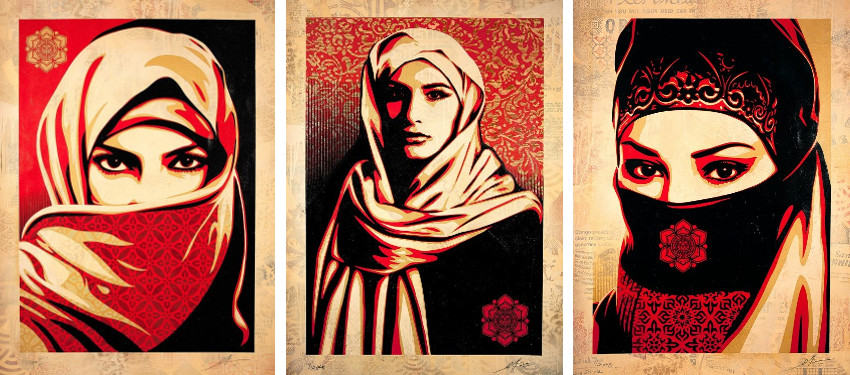
ANDRE THE GIANT
Frank Shepard Fairey was built-in and raised in Charleston, Southward Carolina. He graduated from the Rhode Island School of Design with a Bachelor of Fine Arts in Illustration. Fairey became involved in Art in 1984 when he started to place his drawings on skateboards and T-shirts. His first major work was reproducing black and white images of the wrestler Andre 'The Giant' Roussimoff.
Andre the Giant Has a Posse is a street art campaign based on a pattern by Fairey created in 1989 in Providence, Rhode Island. Distributed by the skater community, the stickers featuring an epitome of André the Giant began showing up in many cities across the U.S.A. At the time, Fairey declared the entrada to exist "an experiment in phenomenology". Over fourth dimension, the artwork has been reused in a number of ways and has spread worldwide.
At the same time, Fairey and fellow RISD student Ryan Bottom, along with Blaize Blouin, Alfred Hawkins, and Mike Mongo created newspaper and vinyl stickers and posters with an image of the wrestler André the Giant and the text "ANDRE THE Giant HAS A POSSE vii' 4", 520 lb", ("seven'four", 520 lbs", or 2.24 chiliad, 236 kg, famously being Andre The Giant's billed height and weight) as an in-joke directed at hip hop and skater subculture, and then began clandestinely (and somewhat fanatically) propagating and posting them in Providence, Rhode Isle and the rest of the Eastern United States.
An in-joke directed at hip hop and skater subculture
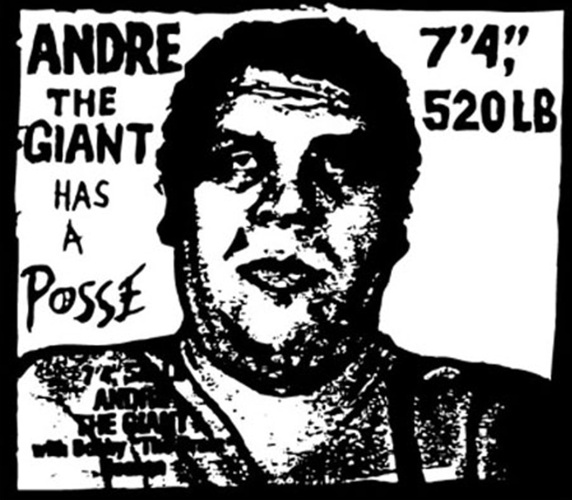
Shepard Fairey: OBEY Behemothic
Fairey altered the work stylistically and semantically into the OBEY Giant. This was also to get iconic and a decisive move in Shepard Fairey's career, particularly in subsequent works that featured the 'Obey' discussion without whatever associated image. In a manifesto he wrote in 1990, and since posted on his website, he links his work with Heidegger's concept of phenomenology. His "Obey" Campaign draws from the John Carpenter flick They Live which starred pro wrestler Roddy Piper, taking a number of its slogans, including the "Obey" slogan, as well as the "This is Your God" slogan. Fairey has also spun off the OBEY clothing line from the original sticker campaign. He as well uses the slogan "The Medium is the Message" borrowed from Marshall McLuhan.
The 'Obey' sticker entrada was an experiment in phenomenology. Shepard Fairey says, "The 'Obey' campaign had no meaning, except to cause people to react, to contemplate and search for meaning. The intention was to provoke people through disassociating words with images that normally accept an underlying motive (i.e. to sell a product)."
Shepard Fairey was responding to the furnishings of subliminal commercialism on audiences, prompting them to question their own role in digesting and utilizing information and to go them to recall beyond their own beingness. Subsequently, the 'Obey Giant' entrada, which was posted throughout the streets of California, led to the artist's arrest on a number of occasions (as it is substantially a course of graffiti); an effect, which resonates in many of his more contemporary works as well.
The OBEY campaign is rooted in the Do It Yourself counterculture of punk rock and skateboarding, but it has too taken cues from popular civilisation, commercial marketing and political messaging. Fairey steeps his ideology and iconography in self-empowerment. With bitter sarcasm verging on reverse psychology, he goads viewers, using the imperative "obey," to have listen of the propagandists out to bend the earth to their agendas.
The artist prompted the audience to question their role in digesting and utilizing data
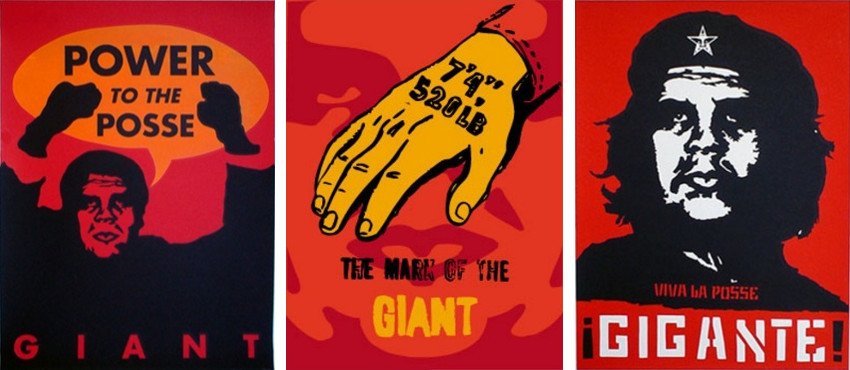
OBEY Clothing
OBEY Habiliment was formed in 2001 as an extension of Shepard's range of piece of work. Aligned with his populist views, the article of clothing became another sail to spread his art and message to the people. The clothing is heavily inspired by classic war machine pattern, work vesture basics, as well every bit the elements and cultural movements Shepard has based his art career on. Through designers Mike Ternosky and Erin Wignall, Shepard works to create designs that represent his influences, ideals, and philosophy.
Autonomously from initiating his own art campaigns, Fairey does select commercial work (he helped to develop a design firm called Studio Number One for this) and he designs for album art, skateboards, film posters, and clothes (he also has his own vesture line which came about as a result of the 'Obey' sticker campaign). Examples of his commercial work include designs for the Black Eyed Peas anthology covers for 'Elephunk' and 'Monkey Business'; the 2009 promotional material for the Earth Hour initiative and a range of creative branding designs for Pepsi, Nike, Electronic Arts, Hasbro, and Netscape, amidst others.
The clothing is inspired past the elements and cultural movements the artist has based his career on
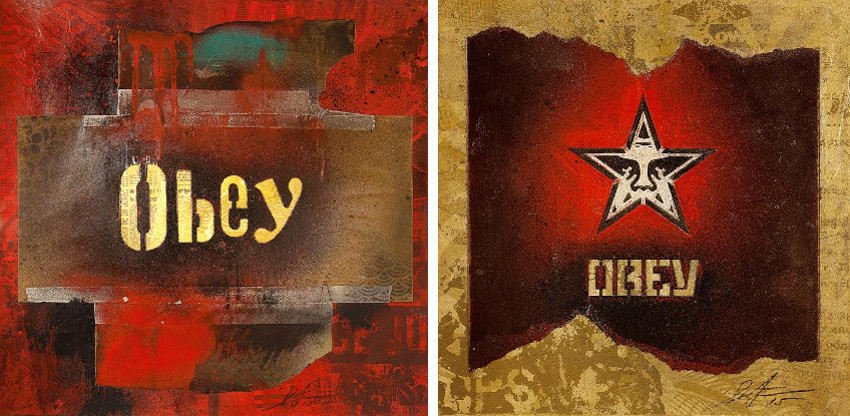
Shepard Fairey and Barack Obama
During the 2008 presidential election, Fairey's poster of Barack Obama - a graphic, vaguely Russian-propagandist-looking portrait of the then-candidate with the discussion HOPE drawn in big, bold letters underneath—achieved the rare feat of becoming a visual emblem of a moment in American history. Obama, of form, won the ballot. The first Obama poster produced by Fairey (produced without any connectedness to the official Obama Presidential Ballot Campaign) showed a portrait of Obama (gazing upwards in the guise of a visionary leader) with the word 'Progress' underneath. Initially, official Obama campaigners kept a altitude from the poster but somewhen embraced information technology, asking Fairey to produce two revised versions. The first replaced the discussion 'Progress' with 'Alter' and the 2d used the word 'Vote'.
But while the Obama poster - as well as a various, complex, and at times controversial trunk of work that stretches back two decades - helped set the stage for Fairey's first solo museum show, titled Supply and Demand, at the Institute of Contemporary Art in Boston final twelvemonth, it as well attracted a different kind of attention. Fairey became embroiled in a contentious and potentially precedent-setting lawsuit with the Associated Press over his unauthorized employ of one of the news service's photographs, which was taken by photographer Mannie Garcia in 2006, as a reference for the Obama portrait. In 2009, Fairey sued the Associated Printing to evidence in court that his portraits of Obama were fair employ of the AP photo and avoid being sued by the AP himself for copyright infringement. Notwithstanding, the AP claims that the artist's apply of the image is copyright infringement; Fairey believes that in making the portrait, he was just exercising his Beginning Amendment rights and that his use of the image as a reference falls nether the category of off-white use. Fairey'due south access in late autumn that he attempted to destroy bear witness of his using the Garcia image as a reference has thrown a new wrinkle into the proceedings. Fairey realized that he was wrong and that he had indeed based his piece of work on the photograph that the AP said he had used, so Fairey panicked and tried to cover his tracks by submitting falsified evidence and attempting to delete the actual testify from his computer. He then went ahead and claimed for months something that he knew was imitation.
Shepard Fairey was sentenced to 300 hours of community service, two years of probation, and a $25,000 after pleading guilty to 1 count of criminal contempt. Government lawyers believed that Fairey could have been fined upward to $3.2 one thousand thousand and also argued that he should spend time in prison (he could have been incarcerated for a maximum of half dozen months).
The lawsuit could have costed him milions of dollars and up to half dozen months in prison
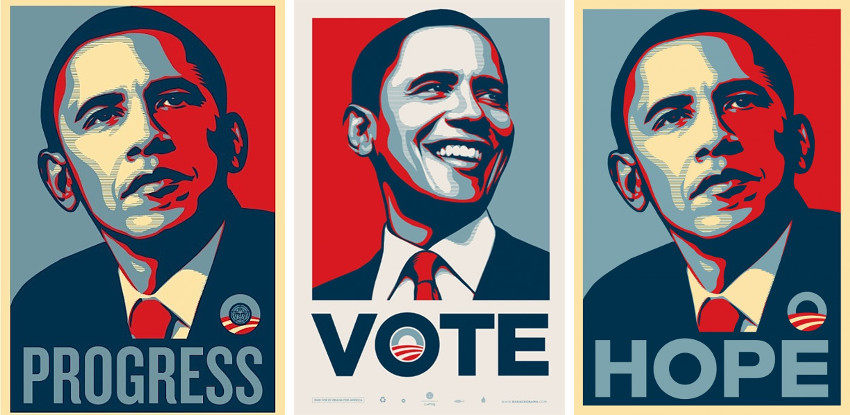
Admiring the Right People
Shepard Fairey, who himself is a member of the punk and skateboarding sub-culture, attributes his rebellious street fine art streak in part to this, as well as Soviet-era propaganda, 1960s-era psychedelic stone poster art and paintings from Works Progress Assistants campaigns - all sources from which Fairey derives neat inspiration. Another of his controversial works was a series of posters titled 'anti-war, anti-Bush' which he created in collaboration with artists Robbie Cond and Mear 1 in 2004. Images in this series include the old President, George Bush, hugging a bomb and another depicting George Bush as the devil. The Obama poster campaign, however, was a shift abroad from this. Information technology did non hold that combative streak reflected in these previous campaigns, but rather the Obama posters captured Fairey's ain forward-looking and hopeful prospects for a new direction for the United States.
"I created the Obama image with a picayune bit of a unlike intention than a lot of other stuff that I make. It'due south not that I haven't put people who I admire on pedestals earlier, but they were ordinarily people like the Black Panthers or the members of Black Sabbath .." He was asked by the heavy metallic band to brand promotional posters for their terminal tour symbolically chosen - The End.
Inspiration is drawn from the Soviet-era propaganda and 1960'southward psychodelic posters
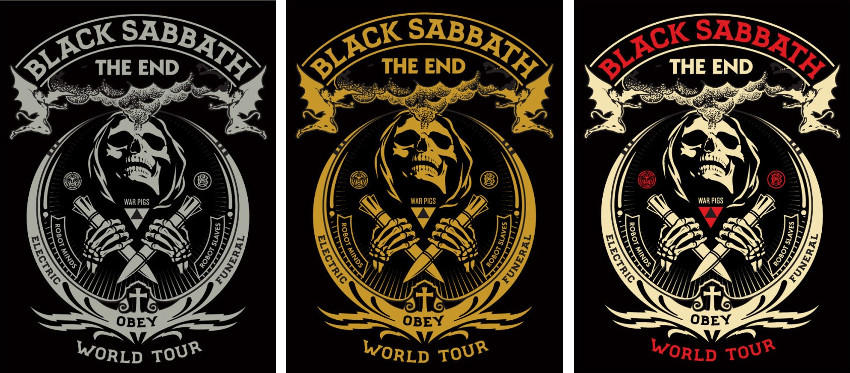
Go out through the Gift Shop: Controversy
Since the release of the picture Exit Through The Souvenir Shop, in that location has been much speculation that the film and story of Mr. Brainwash are a hoax concocted by Banksy and Shepard Fairey themselves. Information technology is a story of Thierry Guetta, a French immigrant in Los Angeles, and his obsession with street art. The film charts Guetta's constant documenting of his every waking moment on film, from a chance meet with his cousin, the artist Invader, to his introduction to a host of street artists with a focus on Fairey and Banksy, whose anonymity is preserved by obscuring his face and altering his voice, to Guetta's eventual fame every bit a street artist himself. It was thanks to Fairey that Guetta gains admission to street art's nearly elusive genius, Banksy, who agrees to have Guetta tag along on some of his operations, such as the kidnapping and vicious murder of a London phone booth, as long as we never see Banksy's face.
However, co-ordinate to a recent interview with artist Ron English, who's possibly best known for his portrait of a rotund Ronald McDonald, the film was entirely existent. English claims that the film started every bit a lawsuit against Thierry Guetta, the enthusiastic street artist wannabe who follows the renowned Shepard Fairey and Banksy through the outset half of the picture show before the doc turns the cameras on Guetta'due south longing to be a vapid, mass-produced, faux street artist named Mr. Brainwash.
Hither's what English language has to say:
"Here'due south what really happened: when we first met Thierry, he was supposed to be making a moving-picture show virtually Shepard. He was filming Shepard all the time, wherever he went. They made a deal, 50/50, we'll make a flick. They shot for five years doing this, Shepard in his Spiderman prime, leaping off buildings and stuff. At the terminate of five years, Shepard says 'Alright, let'due south put the moving picture together,' and Thierry said 'I'm non giving you the footage.' He'south actually quite smart and can be a little devious -- he figured 'I only took away five years of your fame,' because in his heart, Thierry always wanted to exist the creative person. He figured he was messing upwards his competition, in a way, and holding onto valuable footage. Shepard didn't quite know what to exercise and filed a lawsuit against Thierry.
Then Banksy figured 'I'm in the aforementioned situation, he has tons of footage for me.' He had some of the only footage of Banksy where you could really see who he was. So he calls up Thierry and said 'I'm sending you a get-go-class ticket to London, get on the airplane, I have to talk to you.' That's when he told Thierry that he would brand a movie virtually him instead, in exchange for the footage, which Thierry turned over to Banksy. That's when they realized that the footage wasn't nearly what they thought information technology might be, simply it turns out they did get a different sort of treasure trove, because you've got a portrait of this weird guy, Thierry."
So Banksy and Fairey thought Guetta was going to ruin them on pic, but so Banksy turned the cameras on Guetta to create a rousing critique of modern art? It sounds like a fair trade and another intriguing twist in this already engaging story.
There was a lot of controversy around The leave through the gift shop
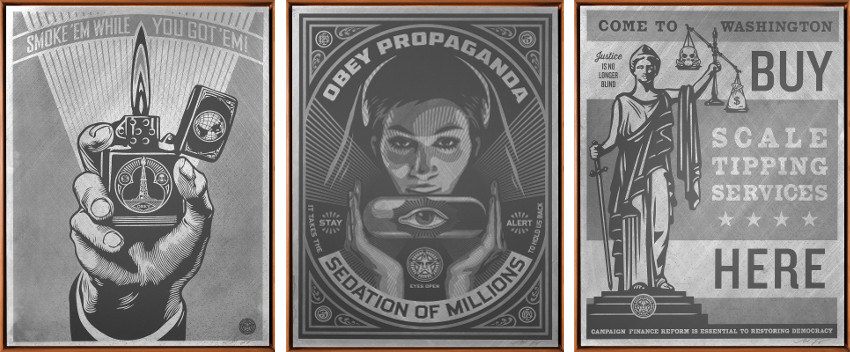
The Simpsons
Simpsons' season 23, episode 15 is titled "Leave Through The Kwik-E-Mart," a play on fellow street creative person Banksy'south 2010 documentary, "Exit Through the Gift Store." In "Exit Through The Kwik-Eastward-Mart," Bart acts as a graffiti artist, plastering Homer's image all over Springfield - that is, until Bart and Millhouse go caught... Shepard Fairey, Ron English, Kenny Scharf and Robbie Conal lent their voices to the episode. In a argument on Fairey's website, the artist writes, "Role of being on 'The Simpsons,' is you lot're beingness honored as a reference point in culture." He subsequently states that "The Simpsons" has been one of his favorite shows for the concluding twenty years.
The Simpsons are one of the artist's favorite shows
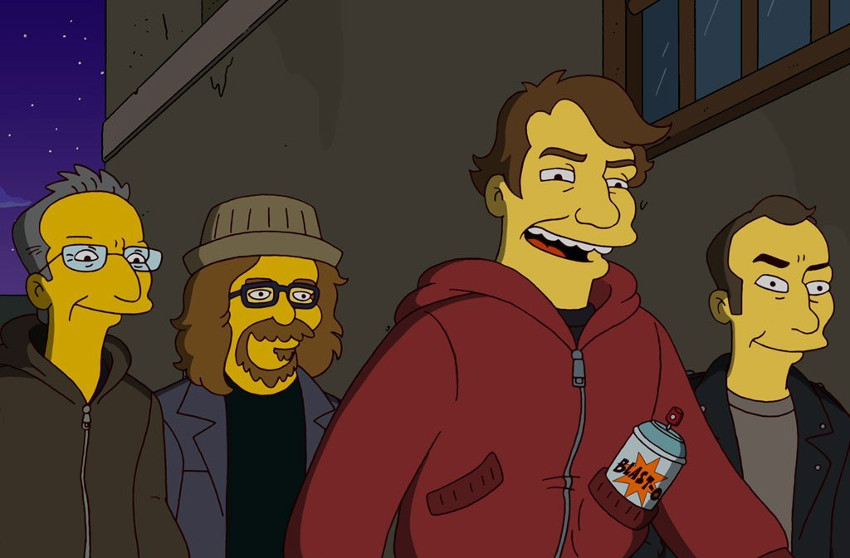
DJ Diabetic and Emcee Insulin
In add-on to his successful graphic design career, Fairey also DJs at many clubs under the proper name DJ Diabetic and Emcee Insulin. Shepard Fairey'south artwork for the exhibition titled 50 Shades of Black is inspired by the 12-inch record cover format. Since 2006, Fairey, a DJ and music enthusiast has continuously created artwork with the record cover template in listen. 50 Shades of Black featured fifty Manus Painted Multiples (HPMs) and a box set with screen print editions of each of the 50 new album cover designs. A record store installation with customized vintage turntables and a portion of the artist's own record drove will also be on view. Viewers tin can participate in the exhibition past selecting records from Fairey'south drove and playing them on the provided record players.
He is too a successful DJ
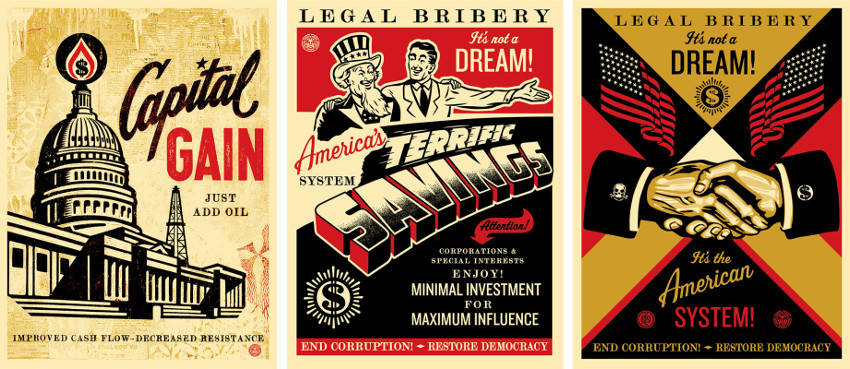
Fairey and Justin Peck: Heartscape
Among his most notable projects, Fairey's recent collaboration with Justin Peck, one of the country'southward virtually sought-after ballet choreographers, really stands out. Their first collaboration happened in the spring of 2015 in Miami, where Fairey's fine art is the backdrop for a new ballet called "Heatscape." Peck explains that he was inspired by Fairey'south murals in Miami'southward Wynwood arts district, part of a permanent street fine art exhibit called "Wynwood Walls." With a collaboration between Peck, the immature resident choreographer of New York Metropolis Ballet who is the hottest new talent in classical trip the light fantastic toe, and famed street artist Shepard Fairey - Heatscape is one of the well-nigh high-contour premieres in MCB's history.
Heatscape is ane of the virtually loftier-contour premieres in MCB's history
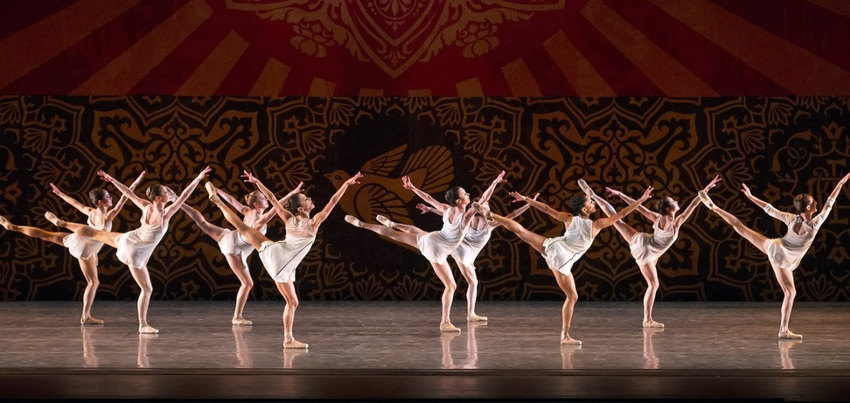
The get-go artist permitted to create an installation at the Eiffel Tower in Paris, Fairey unveiled Earth Crisis to time with the COP21 Climate Conference in the city. He has been promoting sustainability-oriented works since the 1990s when he first designed campaign fabric for influential environmental groups – the installation in Paris was a continuation of those ideas. In 2017, for Trump's inauguration, Fairey collaborated with Ernesto Yerena and Jessica Sabogal, creating a number of posters with hopes of addressing the xenophobic rhetoric of the newly elected president. The posters depicted minority Americans – blackness, Latina, Muslim, and Native American women. Reminiscent of the Hope poster, these new works as well spread the messages of strength and optimism.
The true nature of street fine art lies in its unpredictability. Yous can't always become explicit permission to practice your affair on the walls. And for Fairey, information technology'southward all almost giving his art to the people, disregarding the obstacles. The fact they liked what they saw pushed his career. And yet, due to the lack of permissions, the creative person got arrested more than a dozen times and even faced felony charges in Detroit. Still, he owns the streets, roaming them in pursuit of a new perfect identify to paint. This kind of persistence has made him one of the most famous artists in the contemporary world.
"In the proper noun of fun and observation."
Shepard Fairey lives and works in Los Angeles.
All images, including the featured – copyright Shepard Fairey.
Source: https://www.widewalls.ch/artists/shepard-fairey
Post a Comment for "Shepard Fairey Helped Create the Art Series ââåwe the People"